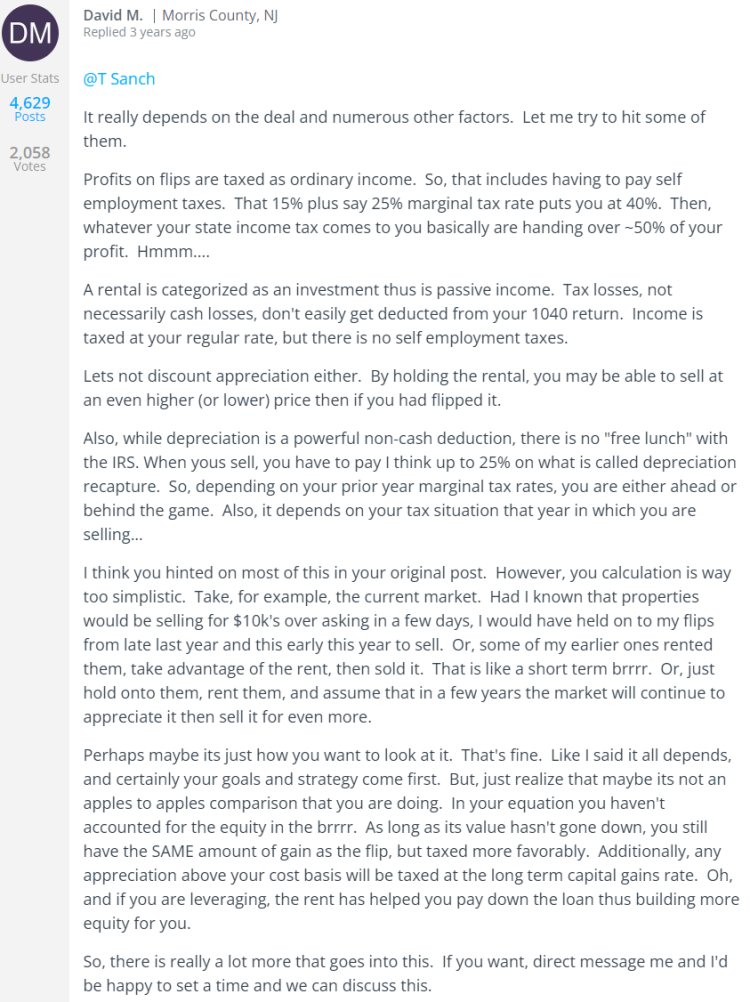In this guide, I’m going to explain the difference between the BRRRR method & fix-and-flip real estate investment strategies.
I’ll also give you examples of each strategy in action, describe the pros and cons, touch on some important nuances (flipping doesn’t always make more money), and show you how to transition from one strategy to the other (and when to do so).
The BRRRR Method Vs. Flix & Flip: What’s The Difference?
The BRRRR method is a long-term investment strategy where you buy and hold a property over years or even decades. Flipping homes, on the other hand, is a short-term investment strategy where you purchase distressed properties, fix them up, and flip them for high profits.
Here are some more important details.
The BRRRR Method Process
- Stands for: Buy, Rehab, Rent, Refinance, Repeat.
- Goal: Build a portfolio of rental properties over time while recycling the intial investment capital.
- Approach:
- Buy: Purchase a property below market value.
- Rehab: Make necessary repairs and renovations to increase its value and rentability.
- Rent: Find tenants and start collecting rental income.
- Refinance: After increasing the property’s value and stabilizing the rental income, refinance the property to pull out equity, which ideally covers most or all of the initial investment.
- Repeat: Use the funds from the refinance to purchase and rehab another property, following the same process.
- Exit Strategy: Hold onto the property long-term for passive rental income and potential appreciation.
Fix-and-Flip Process
- Goal: Buy a property, renovate it, and then sell it for a profit in a relatively short period.
- Approach:
- Buy: Purchase a property signficantly below its potential after-repair value (ARV).
- Rehab: Quickly and efficiently make repairs and updates to significantly increase its market value.
- Sell: List and sell the property at its ARV or close to it.
- Exit Strategy: Sell the property as soon as possible after the rehab to realize a profit and move on to the next project.
BRRRR Method Case Study / Example
Here’s an example of what the numbers might look like on a successful BRRRR method deal…
- Buy:
- Purchase Price: $100,000
- Closing Costs: $5,000
- Rehab:
- Rehab Costs: $25,000
- Total Cost: $130,000 (funded by a loan).
- Rent:
- Monthly Rent: $1,200
- Annual Rent:: $14,400
- Cash-Out Refinance:
- New Appraised Value (after rehab & holding for 12 months): $180,000
- New Loan Amount (80% of appraised value): $144,000
- Cash Pulled Out ($144,000 – $130,000): $14,000
- New Monthly Mortgage Payment (4% interest, 30 years): $630
- Repeat:
- With the $14,000, you can use that as a down payment to repeat the process on another property.
Fix & Flip Case Study / Example
Here’s an example of what the numbers might look like on a successful fix-and-flip deal…
- Buy:
- Purchase Price: $150,000
- Closing Costs: $7,500
- Rehab:
- Sell:
- After-Repair Value: $250,000
- Selling Costs (agent commissions, closing costs): $15,000
- Profit Calculation:
- Gross Profit: ARV – (Purchase Price + Closing Costs + Rehab Costs + Selling Costs)
- $250,000 – ($150,000 + $7,500 + $40,000 + $15,000) = $37,500 net profit
In the BRRRR example, the investor ends up with an asset that produces a net annual cash flow of $7,040 and has potential for appreciation. They’ve also recouped most of their original capital, allowing them to invest in another property.
In the flipping example, the investor realizes a profit of $37,500 in a shorter time frame. However, once the property is sold, the profit is realized and there’s no longers a cash flow or potential for appreciation from that particuarl property.
Pros & Cons of House Flipping
Here are the pros and cons of house flipping to consider.
Pros:
- Quick Profit Potential: When done correctly, flipping can offer a faster return on investment compared to other real estate strategies.
- Tangible Value Creation: Flippers can directly improve a property’s value through renovations and upgrades.
- Market Knowledge Growth: Regularly buying and selling properties can enhance your understanding of local real estate markets.
- Hands-On Involvement: For those who enjoy physical work and tangible results, flipping can be personally rewarding.
- Diversification: It allows investors to diversify their real estate portfolio if they’re also engaged in other long-term investment strategies.
Cons:
- High Risk: If not properly assessed, a flip can result in significant financial losses, especially if unforeseen problems arise during renovation.
- Capital Intensive: Flipping requires significant upfront capital for both the property purchase and renovations.
- Tax Implications: Profits from a flip are usually considered short-term capital gains, which may be taxed at a higher rate than long-term gains.
- Market Dependence: A downturn in the local property market can turn a profitable flip into a financial drain.
- Stress and Time-Consuming: Managing renovations, especially unexpected issues, can be both time-intensive and stressful.
Pros & Cons of The BRRRR Method
Here are the pros and cons of the BRRRR method to consider…
Pros:
- Leverage: Once refinanced, the BRRRR method allows investors to pull out most, if not all, of their initial capital, enabling them to reinvest in another property while keeping the current one.
- Cash Flow: After refinancing, the property can become a long-term rental, providing a consistent monthly income.
- Build Equity: Through both the rehabilitation process and the natural appreciation of property values over time, investors can build significant equity.
- Tax Benefits: Rental properties offer various tax deductions, including interest, property taxes, and depreciation.
- Portfolio Expansion: As initial investments are recouped through refinancing, investors can rapidly grow their real estate portfolios without substantial new capital.
Cons:
- Refinancing Risks: If property appraisals come in lower than expected, investors might not recoup all of their initial investments, leading to capital being tied up.
- Over-leveraging: If done recklessly, continuously borrowing can lead to being over-leveraged, increasing financial risk.
- Management Intensity: Multiple rental properties require substantial management. While property management companies can help, they also reduce the overall cash flow.
- Market Volatility: Property values and rental rates are not guaranteed. A downturn can affect both the refinancing potential and rental income.
- Increased Complexity: Juggling the buying, rehabbing, renting, and refinancing processes requires careful planning and can be more complex than other investment strategies.
BUT… Doesn’t House Flipping Make More Money?
If you looked at the examples above and thought to yourself, “Wait. Doesn’t flipping properties make a lot more money a lot more quickly than the BRRRR method does?”
And the answer is yes, sort of.
In fact, one investor from Miami, Florida pointed this out on BiggerPockets…
So what gives?
Why would you ever BRRRR properties instead of flipping them?
The obvious answers are…
- Flipping homes is higher risk (what if the market takes a turn while you’re fixing up the property?)
- BRRRR method provides more passive income and builds more long-term wealth than flipping properties.
Here’s a more nuanced answer from another user on BiggerPockets…

The gist is this: you also have to account for taxes and appreciation, which are generally much more favorable metrics when using the BRRRR method than when flipping properties.
So in some cases you can make more money flipping homes (and faster) than with the BRRRR method. But not always. The real kicker is the property itself. And the best investors choose to fix-and-flip or BRRRR on a property-by-property basis — they don’t just choose one investment strategy and stick to it tooth and nail.
What makes a good fix-and-flip property?
- Buy Low: Able to purchase significantly below the after-repair value (ARV).
- Clear Rehab Plan: A detailed, cost-effective renovation strategy that doesn’t go over budget.
- Profit Margin: After all costs, there should be a signficant profit margin (typically at least 30% ARV — see the 70% rule).
- Quick Sale Potential: Located in a hot or stable market where homes sell quickly.
- Comparative Stats: Recent similar sales (comps) that support your projected ARV.
- Limited Major Repairs: Avoiding properties with expensive hidden issues like foundational problems or major system failures (unless factored into the price).
- Short Holding Costs: Ability to quickly renovate and sell to reduce the time paying for holding costs.
What makes a good BRRRR property?
- Buy Low: Able to purchase below market value, providing equity right away.
- Rehab Potential: Cost-effective repairs that will increase its value signficantly.
- Strong Rental Market: The property is in an area with strong rental demand.
- Rentability: Attractive to potential tenants in terms of size, features, and location.
- Refinance Potential: After rehab, the property should appraise at a higher value to pull out most or all of the invested capital.
- Holding Costs: Ability to carry the property during the rehab and rent-up periods. Consider property taxes, insurance, and potential mortgage costs.
- Long-Term Potential: Potential for long-term appreciation and consistent cash-flow.
What To Do When Your BRRRR Won’t Cash-Flow…
- Re-evaluate Rent:
- Survey the local market to ensure you’re charging competitive rent.
- Consider offering short-term promotions or incentives for longer leases.
- Decrease Expenses:
- Refinance for a lower interest rate or longer term to reduce monthly payments.
- Audit property management costs, maintenance fees, or insurance for potential savings.
- Value-Add Improvements:
- Invest in minor improvements that can justify higher rent (e.g., modern appliances, landscaping).
- Opt for Short-Term Rentals:
- Consider platforms like Airbnb or Vrbo for potentially higher rental income, especially if located in a high-demand tourist area.
- Lease Option:
- Offer tenants a rent-to-own agreement, which may allow for a higher monthly rent and a future sale.
- Re-evaluate Property Management:
- If using a property management company, consider switching to a more cost-effective or efficient one, or self-managing if feasible.
- Consult with a Financial Advisor:
- Seek guidance on restructuring your portfolio or obtaining better financing options.
What To Do When Your Flip Won’t Sell…
- Reassess Listing Price:
- Compare your property with recent comparable sales in the area. It might be priced too high for the current market.
- Enhance Staging and Presentation:
- Invest in professional staging, photography, and virtual tours to make your listing more appealing.
- Expand Marketing:
- Utilize a broader range of marketing channels, including social media, local publications, and real estate websites.
- Hire a Different Realtor:
- If your current agent isn’t producing results, consider switching to someone with a stronger track record or a fresh marketing approach.
- Offer Incentives:
- Consider paying for closing costs, offering a home warranty, or including bonuses (like appliances) in the sale.
- Feedback Collection:
- Seek feedback from viewers or open house attendees. There might be a consistent objection that can be addressed.
- Consider Renting:
- If the property isn’t selling, you can opt to rent it out until market conditions become more favorable.
- Lease-to-Own Option:
- Offer potential buyers a rent-to-own agreement which can open the door for those who might not qualify for traditional financing.
- Make Additional Improvements:
- Address common objections (e.g., outdated kitchen or lack of landscaping) to enhance appeal.
- Evaluate Market Timing:
- Sometimes it’s a matter of market conditions. You might consider waiting for a more favorable selling season.
Want to Learn More?
You should have a good idea of the difference between the BRRRR method and the fix-and-flip investment strategy. If you have further questions, feel free to leave a comment below! And here are some additional resources from our blog if you still have questions…



